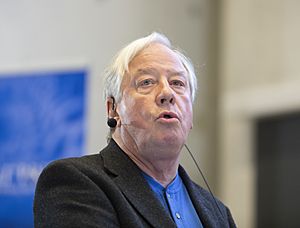Robert Fettiplace facts for kids
Quick facts for kids
Robert Fettiplace
|
|
|---|---|
 |
|
| Born |
Nottingham, England
|
| Nationality | British |
| Alma mater | Cambridge University |
| Awards | Kavli Prize in Neuroscience (2018) |
| Scientific career | |
| Fields | Neurobiology |
| Institutions | University of Wisconsin–Madison |
Robert Fettiplace is a famous British neuroscientist. He is a professor at the University of Wisconsin–Madison in the United States. He has done very important research on how our ears work and how we hear.
Contents
How We Hear: Robert Fettiplace's Discoveries
Robert Fettiplace has spent his career studying how animals, including humans, hear sounds. In 1976, he and another scientist, Andrew Crawford, found a new way to study tiny cells in the ear. These cells are called hair cells. They are super important for hearing.
Hair Cells and Sound Tuning
Their experiments were the first to show how hair cells respond to sound. They discovered that each hair cell is like a tiny radio tuner. It is set to hear a specific sound frequency, which is like a particular pitch. This means some hair cells hear high sounds, and others hear low sounds.
They also found that much of this "tuning" happens because of how electricity moves inside the hair cell. This process is called electrical resonance. It helps the ear pick out different sound frequencies very clearly.
How Hair Cells Work
Later, Dr. Fettiplace's work showed more about this electrical tuning. He found that tiny channels in the hair cell's outer layer, called potassium channels, control this tuning. The number and speed of these channels change how the cell responds to sound. More channels or faster channels mean the cell can hear higher frequencies.
Different types of potassium channels work together with other channels, called calcium channels. This teamwork creates the electrical resonance that helps us hear. This amazing system is found in almost all animals with backbones, except for mammals like us.
Sound to Electrical Signals
Dr. Fettiplace also studied the tiny hair-like structures on hair cells, called stereocilia. He found that these tiny hairs can move back and forth when they sense sound. This movement helps turn sound vibrations into electrical signals. These electrical signals are then sent to the brain, allowing us to understand what we hear. His research helps us understand how our ears change sound into messages our brain can understand.
Awards and Honours
Robert Fettiplace has received many important awards for his scientific work.
- In 1990, he was chosen as a Fellow of the Royal Society (FRS). This is a very high honour for scientists in the United Kingdom.
- In 2012, he was also elected a Fellow of the American Academy of Arts and Sciences.
- In 2018, Dr. Fettiplace shared the Kavli Prize in Neuroscience. He shared this award with two other scientists, A. James Hudspeth and Christine Petit. This prize is given for outstanding achievements in science.
- In 2020, he also received the Louisa Gross Horwitz Prize.

